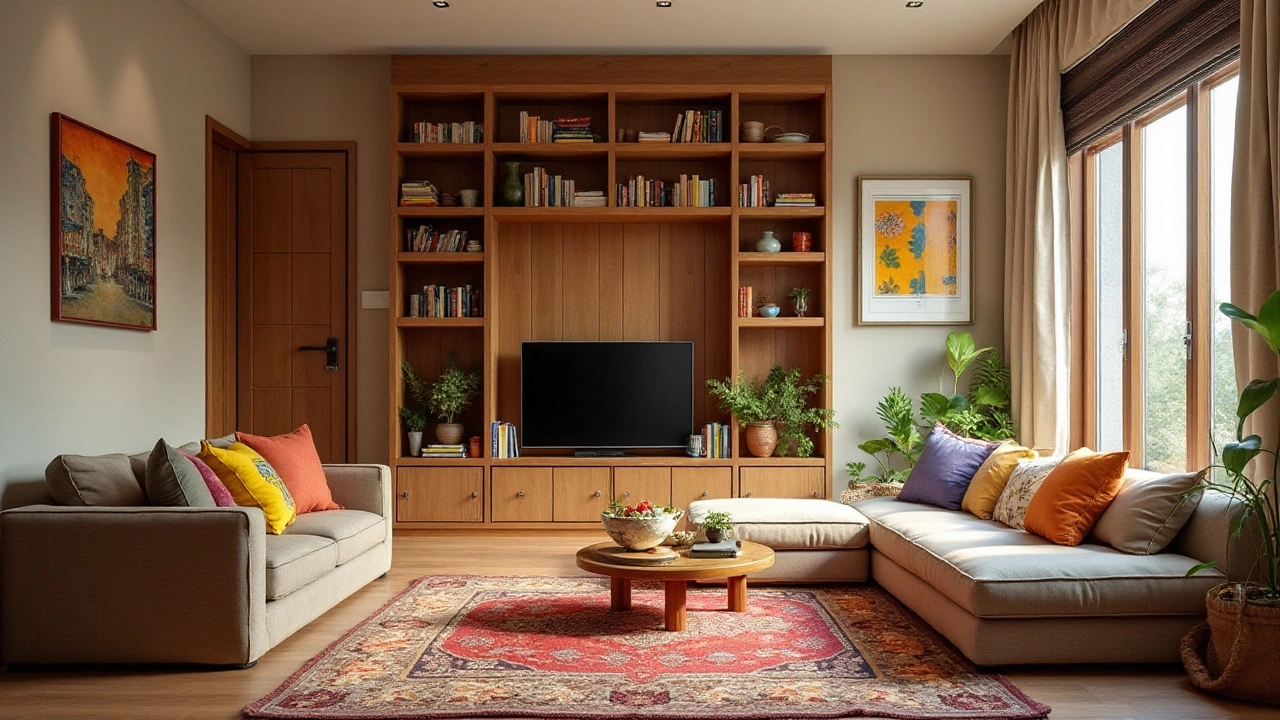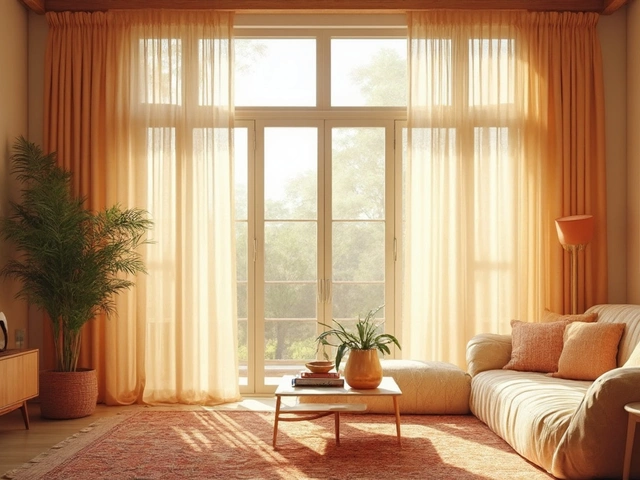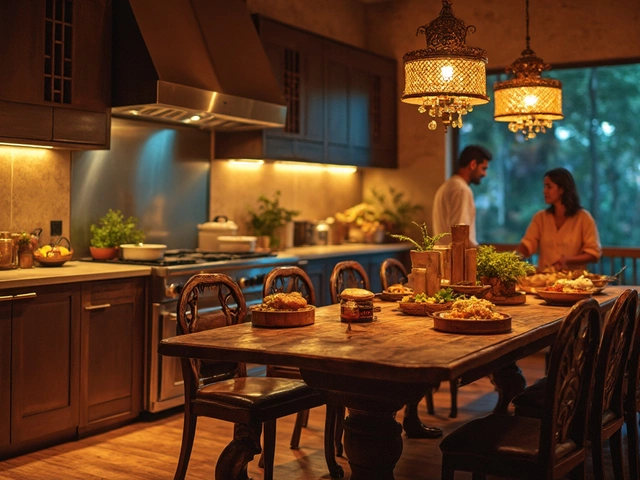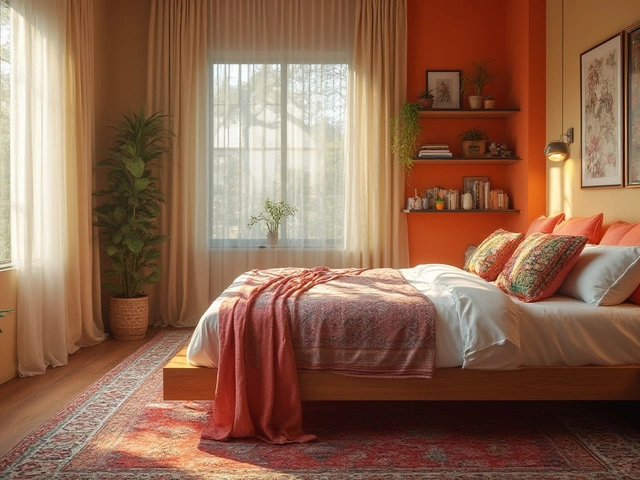Living in a small house can quickly turn into a game of Tetris if you're not careful, but the good news is, you can win this game with the right moves. Embracing smaller spaces means embracing creativity; it's about seeing the potential in every nook and cranny while ensuring every item has its rightful place.
In this article, we'll dive into some clever strategies to maximize storage space in your small home, transforming it from cramped to cozy by using areas you probably never thought of. Whether you're living in a bijou apartment or a snug cottage, these tips will help you reimagine your space, ensuring it's both practical and stylish.
- Vertical Storage Magic
- Multifunctional Furniture
- Maximizing Closet Space
- Underutilized Spaces
- Organizational Tidbits
Vertical Storage Magic
When it comes to finding extra space in a small home, many people forget to look up. Utilizing vertical storage is not only smart but essential for compact living. Think about your walls as more than just boundaries; they are blank canvases waiting to be transformed into functional storage spaces. Shelving units are undoubtedly the most popular go-to solution, but the key lies in choosing shelves that blend practicality with visual appeal.
Floating shelves offer the perfect combination of form and function. Besides being aesthetically pleasing, they open up the floor, giving the illusion of more space. Installing them above furniture like a couch or bed maximizes wall space without cluttering the living area. Another innovative idea involves the use of pegboards as an adaptable solution. Originating from industrial use, pegboards provide flexibility. You can adjust hooks and shelves according to your needs, making them ideal for kitchens, offices, or kids' rooms.
Adding vertical storage in the form of tall, slim bookcases also makes a significant impact. Consider taking bookcases to the ceiling for maximum storage capacity. To avoid a top-heavy feeling, design experts suggest keeping heavier items on lower shelves and using the higher ones for decor or lightweight items.
"In a world where space is a premium, going vertical isn't just an option; it's a necessity," Léonie Watson, an interior design scholar, once said.Incorporating tension rods between walls turns awkward spaces into valuable real estate for hanging items, from kitchen utensils to cleaning tools.
For those who love plants but lack floor space, vertical gardens can be a green oasis. Wall planters or hanging gardens not only purify the air but add a splash of color and life to any room. If privacy is a concern, wall-mounted storage units with doors provide a neat way to keep things tidy while ensuring your belongings are not on public display. By thinking vertically, you make the most out of potentially wasted space, keeping the home organization at its peak.
Many people are surprised to learn that vertical storage options extend beyond typical shelving and bookcases. Employing ceiling-mounted hanging racks in garages or utility rooms takes advantage of spaces that usually go untouched. Integrating hooks and hangers for bicycles, ladders, or bulky sports equipment turns an area that might be underutilized into a storage hub, freeing up essential floor space. The act of looking up extends your storage potential tenfold, proving that small homes can be both functional and stylish with just a few creative touches.
Multifunctional Furniture
In a world where space is at a premium, using multifunctional furniture is a game-changer for maximizing storage in a small home. The beauty of these pieces lies in their ability to perform dual functions, which can significantly enhance both your living area and your storage capacity. Think about the last time you admired an ottoman; it may have been just a comfortable footrest, but with a smart design twist, it could double as a storage bin for blankets and magazines. Consider investing in a sofa bed, which offers both seating and sleeping space without sacrificing style. Multifunctional furniture is all about being savvy with your selections, without cramming the place full.
Imagine the elegance of a coffee table that opens up to reveal ample storage space for board games, books, or those remote controls that always seem to vanish the minute you sit down. Compact living often requires thinking outside the box. For instance, dining tables with drop-leaf sides can expand when you have guests over, and then tuck neatly into a compact rectangle when not in use. This turns your dining area into a multi-use zone without adding to clutter. It's not only about functionality; the aesthetics of these smart designs often blend seamlessly with your decor, maintaining the style of your home while enhancing its efficiency.
Now, let’s dive into the specifics. Consider beds with built-in drawers underneath or headboards that serve as shelving units for books and other essentials. These are perfect examples of how you can make the most of bedroom storage. Using walls creatively is another tip, perhaps a fold-out desk mounted to a wall that can be lifted out of the way when you’re off-duty, the sheer brilliance of such solutions shows that even in the coziest of homes, there are opportunities to carve out both comfort and utility. In a statement during a home design conference, designer Susan Schwartz declared,
‘Good design solves real problems, and there's none greater than creating storage in a small home.'
Practicality compels us also to explore furniture like stools and chairs that can be stacked or nested under tables, freeing up floor space when not needed. Wall-mounted TV units with shelves give you a place for media boxes and books, adding layers of functionality. In the kitchen or dining room, movable islands or expandable countertops can be invaluable, offering prep space and storage in one convenient location. This multipurpose approach aids in thoroughly utilizing your space, ensuring every square inch works towards a cohesive home environment.
Let's take a moment to explore some compelling statistics about why stacking up on multifunctional furniture is a wise choice. According to a survey from the Home Improvement Research Institute, over 70% of small homeowners consider multipurpose furniture essential when managing limited space. Another interesting note from their findings indicated that those who invested in furniture optimized for space savings reported a 20% reduction in household clutter. This indicates a broad recognition of the value of such furniture not just as a luxury, but as a necessity for those in confined spaces. As environments continue to evolve, the ingenuity and availability of multifunctional furniture are likely to keep pace, offering fresh solutions to age-old problems of space and storage.
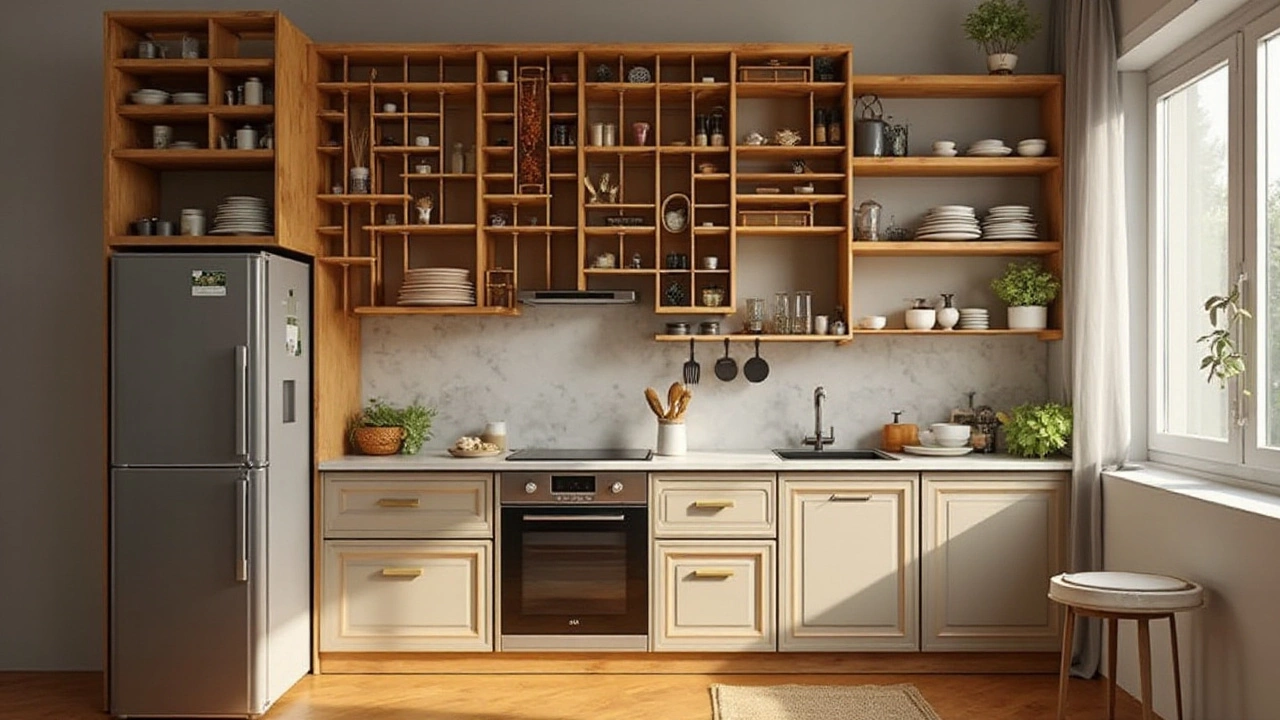
Maximizing Closet Space
For many, closets become a black hole where clothes are forgotten, swallowed into the distant corners, lost under layers of lesser-used items. But with some clever tweaks, your compact closet space can become a beacon of order and accessibility. The trick is to think vertically and make use of every inch available, much like with small home storage solutions elsewhere in your abode. Start by considering double hanging rods, which effectively double your hanging space. The top rod holds your longer garments like dresses and coats, while the bottom one is perfect for shorter clothes such as shirts and pants. Pair this with a shoe organizer on the back of your closet door to further free up floor space.
Adding shelves above the hanging rods allows you to store items that you might not need every day but still want nearby, such as seasonal clothes or accessories. For those with a bold streak, clear containers keep things visible, ensuring you don't forget what you have. A quotation from famed organization expert Marie Kondo illuminates this well, reminding us that, "When you put your house in order, you put your affairs and your past in order, too." This idea resonates particularly strongly in our closets, where confronting cluttered chaos often parallels untangling past choices.
Small homes often come with small closets, and maximizing this space means not letting any part go to waste. Installing a set of hooks inside the door or along the side walls can offer a home for ties, belts, scarves, or even jewelry. Don't forget about the closet floor, either. Low-profile bins or boxes can house shoes, bags, or other items, and many find that rolling these solutions in and out makes them much more user-friendly. Hanging fabric shelves can also be looped onto the existing rod, offering perfect cubbies for sweaters or folded jeans.
It can be beneficial to do a yearly overhaul of your closet, ensuring everything earned its keep. Many experts suggest using the hanger method — as you wear items, flip the hanger around, and at year's end, consider donating the pieces that remain unturned. Adding simple lighting solutions like stick-on LEDs can also work wonders; an illuminated closet makes it easier to find everything while also creating an airier feeling. Remember, the art of maximizing space is a balance between practicality and style, and with thoughtful touches, your closet can embody both.
Innovations in closet design have made it easier to have tailored solutions even for compact living spaces. Sliding doors can save several square feet, and mirrored options have the added benefit of visually enlarging a room. High-quality hangers keep clothing in good shape and utilize space more efficiently. A key piece of advice is to rotate your wardrobe seasonally. Keeping only in-season clothes at hand not only prevents a crammed closet, but it also makes choosing an outfit straightforward, leaving you more time to focus on the beauty of small home living.
Underutilized Spaces
Have you ever glanced at the unused areas of your home and wondered if they're harboring untapped potential? These often-overlooked spaces, from beneath the stairs to the empty expanse under your bed, are prime real estate in a small home. Let's start with the space under your staircase. Many homeowners either leave it bare or fill it with random clutter, but with some thoughtful planning, you can transform this area into smart storage or even a cozy nook. One way to approach this is by installing custom drawers or a shelving unit to stow away items like cleaning supplies or seasonal decorations, maximizing storage without obstructing the flow of space in your small home.
Don't overlook the gaps between or above your furniture and the walls. By installing floating shelves, you can create attractive storage displays that not only provide space for books or decorative items but also draw the eye upward, making rooms appear more spacious. These shelves turn unused wall areas into a gallery of function and style. Similarly, adding hooks to the back of doors can offer convenient storage for items like bags or robes, keeping them out of sight yet easily accessible. Did you know that by elevating furniture like couches and chairs with legs, you can free up space beneath and create an area for stashing bins or baskets?
Consider the humble areas under beds and couches, which often go unnoticed except for a few dust bunnies. Equip yourself with under-bed storage boxes or vacuum-sealed bags to tuck away off-season clothes or guest linens. As a rule of thumb, always opt for sturdy, well-fitting options to keep your belongings safe and organized. Remember, the key is to avoid turning these spaces into black holes where items are forgotten—maintain a system for easy access and retrieval. On a similar note, adjustable shelves inside kitchen cabinets can utilize vertical space efficiently, offering more room for your pots, pans, and pantry items.
“The details are not the details. They make the design.” - Charles Eames
Compact living sometimes requires you to think vertically and horizontally. Even your doorways can become a part of the storage solution. Consider installing a high shelf or rail above exterior and interior doors to hang hats, umbrellas, or even aesthetically pleasing baskets. It’s an understated way of keeping your essentials visible yet out of direct sight. Meanwhile, bay windows with built-in seating can provide hidden compartments for extra storage. This technique keeps items nearby but cleverly concealed, ensuring a tidy appearance and maintaining free movement throughout your living area.
Every inch counts when it comes to storage-savvy living, and knowing where to look and how to use these underutilized spaces can make a world of difference. In places where tight spaces seem to dictate your choices, being innovative with interiors can lead to solutions that are both practical and aesthetically pleasing, epitomizing the close connection between form and function. A space-efficient environment not only meets organizational needs but often inspires a more minimalist lifestyle. Dive into the challenge of making every corner count, and you'll find that your small home can be as comfortable and accommodating as homes twice its size.
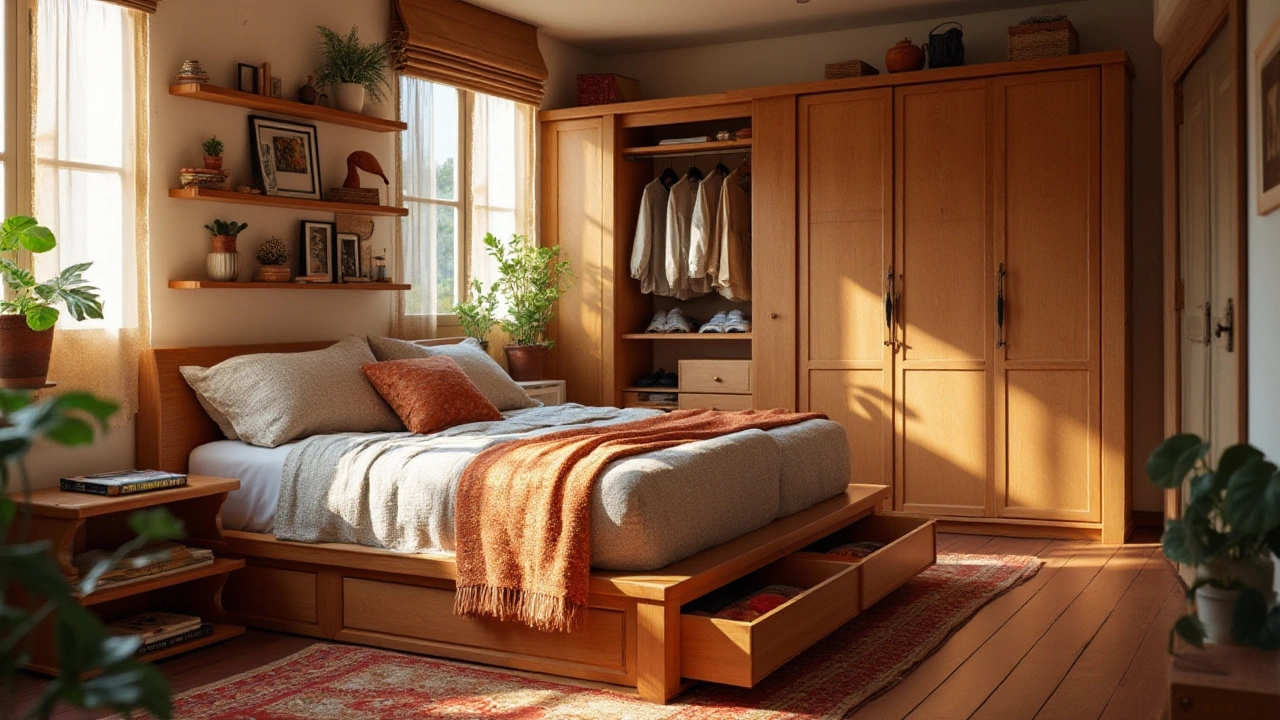
Organizational Tidbits
Delving into the realm of home organization, there's an art to finding a place for everything, especially within the confines of a small home. The secret lies in the meticulous art of sorting and labeling, which not only maximizes storage but also enhances convenience. To start, consider the use of clear containers—these transparent wonders can make a huge difference when it comes to quickly locating items. Whether it’s a box of winter accessories or a collection of art supplies, seeing the contents at a glance simplifies the process of retrieval and placement.
Labels are another trusty companion on this journey to greater organization. It's not just for the aesthetically inclined—labels serve a practical function by reducing the time spent searching through piles of similar goods. A well-labeled box cuts down on clutter and confusion, turning your living space into an efficient hub. And don’t limit yourself to store-bought tags; personalized labels can add a touch of personality while still being highly functional.
The next trick up your sleeve is creating zones. By dividing your space into specific areas designated for certain tasks or items, you're breaking down the chaos into manageable sections. Whether it's a reading nook neatly organized with a stack of books and a cozy blanket or a cooking section with spices and utensils at the ready, defined zones can minimize overlap and clutter. Such organization also helps nurture the spirit of mindfulness in your daily activities, ensuring every item serves a purpose where it resides.
Let's not forget about the simple yet potent use of hooks. From the backs of doors to inside cupboards, hooks can transform underused vertical areas into efficient storage places. Hanging things like jackets, handbags, and even kitchen utensils can free up floor and drawer space in a compact living environment. These small changes can have a big impact on the accessibility and orderliness of your home.
For those willing to dive deeper, color-coding is a tactic that goes beyond aesthetics and functionality. This method involves segregating items by hue—for instance, green for gardening tools or yellow for office supplies—which further aids in visual organization and quick access. It adds another layer to the labeling system, catering to visual learners who grasp order through color associations.
If you're after insights into professional organizational prowess, look no further than Marie Kondo, whose decluttering philosophy has guided countless households.
"The objective of cleaning is not just to clean, but to feel happiness living within that environment," she advises, highlighting the emotional and psychological benefits of a well-organized home.Such insights can be motivating for anyone looking to achieve not just a tidy, but a harmonious home environment in a compact living setting.
Finally, let us explore the figures that speak for themselves. A study conducted by the ClosetMaid company revealed that most American homes could improve their storage efficiency by at least 25% by adopting better organizational habits. Understanding this, investing time in organizing your home can significantly impact how you utilize your storage, making daily life smoother and more pleasant.
